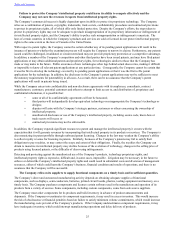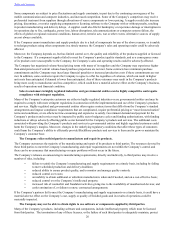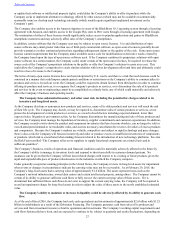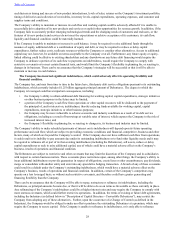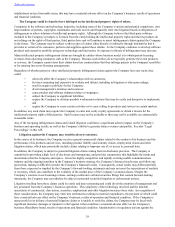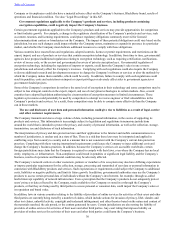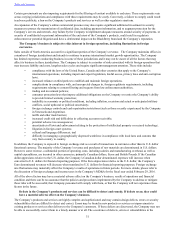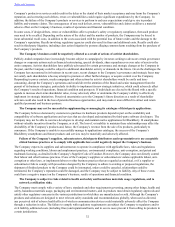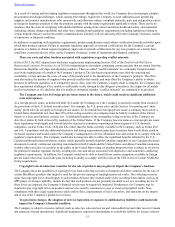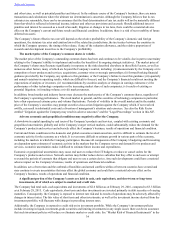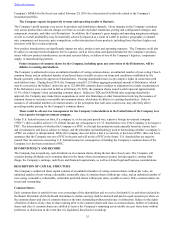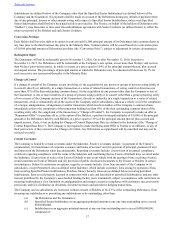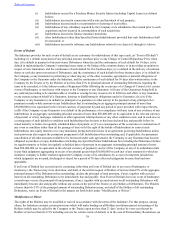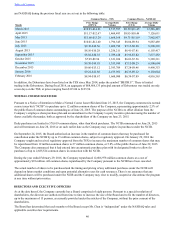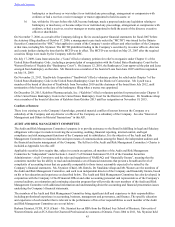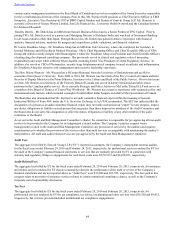Blackberry 2016 Annual Report Download - page 43
Download and view the complete annual report
Please find page 43 of the 2016 Blackberry annual report below. You can navigate through the pages in the report by either clicking on the pages listed below, or by using the keyword search tool below to find specific information within the annual report.
Table of Contents
34
and other taxes, as well as potential penalties and interest. In the ordinary course of the Company’s business, there are many
transactions and calculations where the ultimate tax determination is uncertain. Although the Company believes that its tax
estimates are reasonable, there can be no assurance that the final determination of any tax audits will not be materially different
from that which is reflected in historical income, indirect and other tax provisions and accruals. Should additional taxes or
penalties and interest be assessed as a result of an audit, litigation or changes in tax laws, there could be a material adverse
effect on the Company’s current and future results and financial condition. In addition, there is a risk of recoverability of future
deferred tax assets.
The Company’s future effective tax rate will depend on the relative profitability of the Company’s domestic and foreign
operations, the statutory tax rates and taxation laws of the related tax jurisdictions, the tax treaties between the countries in
which the Company operates, the timing of the release, if any, of the valuation allowance, and the relative proportion of
research and development incentives to the Company’s profitability.
The market price of the Company’s common shares is volatile.
The market price of the Company’s outstanding common shares has been and continues to be volatile, due in part to uncertainty
relating to the Company’s ability to implement and realize the benefits of its ongoing strategic initiatives. The market price of
the Company’s shares may fluctuate significantly in response to the risks described elsewhere in these Risk Factors, as well as
numerous other factors, many of which are beyond the Company’s control, including: (i) announcements by the Company or its
competitors of new products and services, acquisitions, customer wins or strategic partnerships; (ii) forward-looking financial
guidance provided by the Company, any updates to this guidance, or the Company’s failure to meet this guidance; (iii) quarterly
and annual variations in operating results, which are difficult to forecast, and the Company’s financial results not meeting the
expectations of analysts or investors; (iv) recommendations by securities analysts or changes in earnings estimates; (v) the
performance of other technology companies or the increasing market share of such companies; (vi) results of existing or
potential litigation; (vii) trading volume; or (viii) market rumours.
In addition, broad market and industry factors may decrease the market price of the Company’s common shares, regardless of
the Company’s operating performance. The stock market in general, and the securities of technology companies in particular,
have often experienced extreme price and volume fluctuations. Periods of volatility in the overall market and in the market
price of the Company’s securities may prompt securities class action litigation against the Company which, if not resolved
swiftly, can result in substantial costs and a diversion of management’s attention and resources. See also the Risk Factor
entitled “Litigation against the Company may result in adverse outcomes” and the “Legal Proceedings” section in this AIF.
Adverse economic and geopolitical conditions may negatively affect the Company.
A slowdown in capital spending by end users of the Company’s products and services, coupled with existing economic and
geopolitical uncertainties globally and in the Company’s target vertical markets, could substantially reduce the demand for the
Company’s products and services and adversely affect the Company’s business, results of operations and financial condition.
Current and future conditions in the domestic and global economies remain uncertain, and it is difficult to estimate the level of
economic activity for the economy as a whole. It is even more difficult to estimate growth in various parts of the economy,
including the markets in which the Company participates. Because all components of the Company’s budgeting and forecasting
are dependent upon estimates of economic activity in the markets that the Company serves and demand for its products and
services, economic uncertainties make it difficult to estimate future income and expenditures.
Economic or geopolitical uncertainties may cause end users to reduce their IT budgets or reduce or cancel orders for the
Company’s products and services. Network carriers may further reduce device subsidies that they offer to end users or attempt
to extend the periods of contracts that obligate end users to use a certain device. Any such developments could have a material
adverse impact on the Company’s business, results of operations and financial condition.
In addition, acts of terrorism and the outbreak of hostilities and armed conflicts within or between countries have created and
may continue to create uncertainties that may affect the global economy and could have a material adverse effect on the
Company’s business, results of operations and financial condition.
A significant portion of the Company’s assets are held in cash, cash equivalents, and short-term or long-term
investments, all of which are subject to market and credit risk.
The Company had total cash, cash equivalents and investments of $2.6 billion as at February 29, 2016, compared to $3.3 billion
as at February 28, 2015. Cash equivalents, short term and other investments are invested primarily in debt securities of varying
maturities. Consequently, the Company is exposed to interest rate risk and its results of operations may be adversely affected by
changes in interest rates. The fair value of short term and other investments, as well as the investment income derived from the
investment portfolio, will fluctuate with changes in prevailing interest rates.
Additionally, the Company is exposed to credit risk on its investment portfolio. While the Company’s investment policies
include investing in liquid, investment-grade securities and limiting investments in any single issuer, there can be no assurance
that such investment policies will reduce or eliminate market or credit risks. See “Market Risk of Financial Instruments” in the



